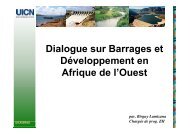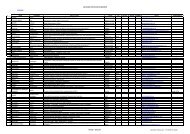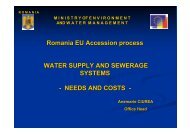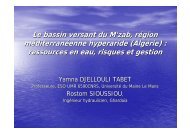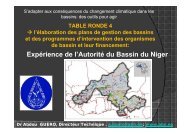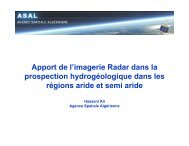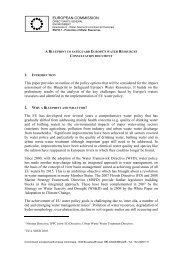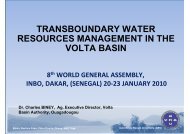The Past and the Future of Flood Management in the Eastern ... - INBO
The Past and the Future of Flood Management in the Eastern ... - INBO
The Past and the Future of Flood Management in the Eastern ... - INBO
Create successful ePaper yourself
Turn your PDF publications into a flip-book with our unique Google optimized e-Paper software.
Table (3): River Regulation <strong>in</strong> Sudan<br />
A new dam is be<strong>in</strong>g constructed at Merowe on <strong>the</strong> Ma<strong>in</strong> Nile, roughly 800 km<br />
downstream <strong>of</strong> Khartoum near <strong>the</strong> 5th Cataract <strong>of</strong> <strong>the</strong> Nile downstream <strong>of</strong> <strong>the</strong> Atbara<br />
River confluence. It is planned that this dam will be operated <strong>in</strong> a similar mode to those<br />
<strong>of</strong> Roseires <strong>and</strong> Sennar <strong>in</strong> order to maximize passage <strong>of</strong> sediment through <strong>the</strong> storage<br />
dur<strong>in</strong>g <strong>the</strong> ris<strong>in</strong>g stage <strong>and</strong> peak <strong>of</strong> <strong>the</strong> annual floods.<br />
Sudan has a long tradition <strong>of</strong> river gaug<strong>in</strong>g dat<strong>in</strong>g from pre-<strong>in</strong>dependence years. In fact,<br />
Sudan has long records <strong>of</strong> good accuracy at many gaug<strong>in</strong>g sites along rivers.<br />
Egypt:<br />
<strong>The</strong> hydrology <strong>of</strong> Egypt is dom<strong>in</strong>ated by <strong>the</strong> Nile River <strong>and</strong> its regulation by HAD. <strong>The</strong><br />
Nile is <strong>the</strong> only river <strong>in</strong> <strong>the</strong> country, <strong>the</strong>re are no tributaries <strong>and</strong> <strong>the</strong> importance <strong>of</strong> this<br />
water source is heightened by <strong>the</strong> aridity <strong>of</strong> <strong>the</strong> climate which features low ra<strong>in</strong>fall <strong>in</strong><br />
coastal areas <strong>and</strong> very little ra<strong>in</strong>fall at all <strong>in</strong> <strong>the</strong> <strong>in</strong>terior.<br />
HAD is located <strong>in</strong> Upper Egypt, <strong>and</strong> <strong>the</strong> lake it creates (Lake Nasser <strong>in</strong> Egypt, Lake<br />
Nubia <strong>in</strong> <strong>the</strong> Sudan) extends 500 km upstream <strong>in</strong>to <strong>the</strong> nor<strong>the</strong>rn limits <strong>of</strong> Sudan. <strong>The</strong><br />
reservoir has a total storage <strong>of</strong> 163 00 MCM, which compares with <strong>the</strong> mean annual<br />
<strong>in</strong>flow <strong>of</strong> 84 00 MCM. As shown <strong>in</strong> Table(4), <strong>the</strong> total storage is divided <strong>in</strong>to three zones.<br />
Accord<strong>in</strong>g to <strong>the</strong> design, <strong>the</strong> dead storage was sufficient to accommodate <strong>the</strong> sediment<br />
<strong>in</strong>flow over a period <strong>of</strong> 500 years. In practice, virtually all <strong>of</strong> <strong>the</strong> sediments are be<strong>in</strong>g<br />
deposited <strong>in</strong> <strong>the</strong> headwaters <strong>of</strong> <strong>the</strong> storage as <strong>the</strong> river waters slow down on enter<strong>in</strong>g <strong>the</strong><br />
lake. Above around 178m, water also beg<strong>in</strong>s to spill laterally from <strong>the</strong> lake to <strong>the</strong><br />
Western Desert through a depression known as Toshka Spillway. Any water above dead<br />
storage is available for release for irrigation, hydropower generation <strong>and</strong> to susta<strong>in</strong><br />
m<strong>in</strong>imum environmentally acceptable flows down <strong>the</strong> river <strong>and</strong> through <strong>the</strong> delta.<br />
Table (4): Lake Nasser Storage Zones<br />
6.5 km downstream <strong>of</strong> HAD, <strong>the</strong> Old Aswan serves to re-regulate hydropower releases<br />
<strong>and</strong> generate additional power. See Figure (6)<br />
9





